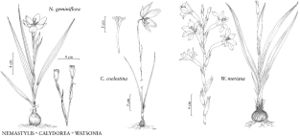Watsonia
Fig. Pl. Gard. Dict., 184, plate 276. 1758.
| Taxon | Illustrator ⠉ | |
|---|---|---|
 | Nemastylis geminiflora Calydorea coelestina Watsonia meriana | Yevonn Wilson-Ramsey Yevonn Wilson-Ramsey Yevonn Wilson-Ramsey |
Herbs, perennial, from corms. Stems simple or branched. Leaves several; blade plane, lanceolate to linear, usually coarse, fibrotic. Inflorescences spicate, erect, many-flowered; bracts green, often flushed with red, unequal, usually outer exceeding inner, apex acute, inner forked apically, firm to leathery. Flowers short-lived, odorless [rarely fragrant], zygomorphic [actinomorphic], distichous; tepals horizontal or suberect, connate into tube, orange, red, or purple [pink, rarely white], ± equal [equal]; perianth-tube funnel-shaped or elongate, expanded distally into wide, horizontal upper part; stamens unilateral [symmetrical], arcuate [declinate], extended horizontally below dorsal tepal; anthers parallel [diverging]; style arching below or above filaments [central], dividing opposite to [beyond] anthers into 3 filiform branches each divided for ca. 1/2 their length, apically stigmatic. Capsules [globose to] oblong, wood-textured, rounded [acute or attenuate]. Seeds several to many, angular, 1-winged or 2-winged [prismatic]; seed-coat light-brown. x = 9.
Distribution
Introduced; s Africa
Discussion
Species 52 (1 in the flora).
Several species of Watsonia are cultivated in the flora area where the winters are mild, especially in California; only W. meriana is truly naturalized. The following have been recorded as persisting for some years around abandoned dwellings, in cemeteries and garbage dumps, and along roads and highways: W. borbonica (Pourret) Goldblatt (both pink- and white-flowered forms), W. fourcadei J. W. Mathews & L. Bolus, and W. marginata (Linnaeus f.) Ker Gawler.
Selected References
None.
Lower Taxa
"divided" is not a number.